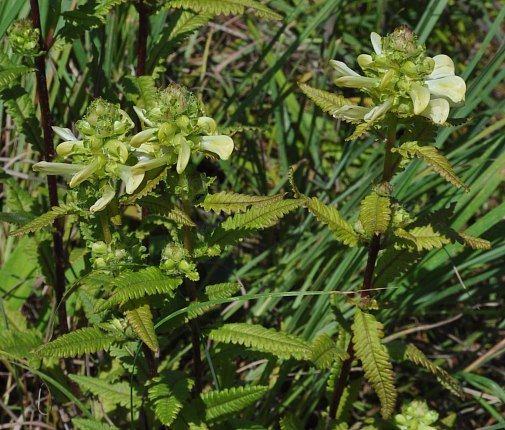Description: This herbaceous perennial wildflower is 1–2½' tall and either unbranched or sparingly branched toward the apex. The stout central stem is hairless. The leaves are up to 5" long and 1¼" across; they are mostly opposite, yellowish green to green, lanceolate-oblong, pinnatifid, hairless, and rather thick-textured. The shallow lobes of the leaves are crenate along their margins; they extend less than one-half the distance to the midveins of the leaves.

The central stem
terminates in a short spike of flowers up to 4" long, and shorter
spikes may occur on the upper lateral stems. The flowers are densely
arranged along these spikes. Each flower is about ¾" long, consisting
of a short tubular calyx, a long tubular corolla, 4 stamens, and an
ovary with a single style. The calyx is pale green or yellowish green
and divided into two truncate lobes; it is usually hairless, although
deciduous hairs may be present during the bud stage of floral
development. The calyx lobes are finely crenate along their truncate
tips. The corolla is pale yellow or cream-colored at maturity; it has
two well-defined lips. The upper lip is in the shape of a curved hood,
while the less conspicuous lower lip terminates in 3 small lobes. The
flowers bloom gradually from the bottom of each spike to its top. The
blooming period occurs from late summer into the fall and lasts about 1
month. Each flower is replaced by a hairless ovoid seed capsule that
extends to about the same length as the calyx. Each capsule contains
numerous small seeds. The root system is fibrous and rhizomatous,
forming vegetative offsets. Swamp Lousewort is a hemiparasite that
extends small feeder roots to the root systems of neighboring plants,
from which it extracts water and minerals.
Cultivation:
The preference is full or partial sun, wet to moist conditions, and any
soil that is not too acidic. This wildflower benefits from the presence
of one or more host plants (there is probably a large number of them),
but it is able to conduct photosynthesis through its leaves and live
off its own root system.
Range & Habitat:
The native Swamp Lousewort is occasional in the northern half of
Illinois, while
in the southern half of the state it is rare or absent. Habitats
include swamps, fens, seeps and springs (in both sunny and wooded
areas), sedge meadows, wet sand prairies, and sandy ditches. This
wildflower is usually found in higher quality wetlands.
Faunal Associations:
The flowers are cross-pollinated primarily by bumblebees, which obtain
both nectar and pollen. After feeding initially on Chelone
glabra (White Turtlehead), later instars of the butterfly Euphydryas
phaeton phaeton (Baltimore) have been to known to feed on the
foliage of Swamp Lousewort and other plants. The caterpillars of the
moth Eosphoropteryx thyatiroides (Pink-Patched
Looper) also feed on Pedicularis spp.
Photographic Location:
A nature preserve in Cook County, Illinois. The photograph was taken by
Lisa Culp (Copyright © 2009).
Comments:
Swamp Lousewort has interesting fern-like leaves and modestly colored
flowers. The unattractive common name, 'Lousewort,' derives from the
mistaken belief that the consumption of this plant by cattle and sheep
could induce an infestation of lice in these animals. In Illinois,
there are only two species in this genus: Pedicularis
lanceolata (Swamp Lousewort) and Pedicularis
canadensis (Wood Betony). The latter species is more common
within the state and prefers drier areas. It is a shorter plant than
Swamp Lousewort and blooms much earlier in the year. Unlike Swamp
Lousewort, the leaves of Wood Betony have lobes that often extend more
than one-half the distance to their midveins. There are additional
species in this genus that can be found in boreal and arctic regions to
the north and in western areas of the United States.